Making a beautiful matcha latte at home is a simple ritual that can transform your morning. It all comes down to whisking sifted matcha powder with a little hot water to create a smooth, vibrant paste, then pouring over your favourite frothed milk. This is the secret to getting that clump-free, café-quality drink right in your own kitchen, with total control over how sweet or rich you want it.
Crafting Your Perfect Homemade Matcha Latte
Think of this as more than just a recipe; it’s about creating your own personal matcha moment. Making a matcha latte yourself isn't just a great way to save a bit of money, it's a chance to build a small pocket of calm and focused energy into your day, perfectly tailored to your taste.
The experience begins with understanding what makes this bright green drink so special. It's not just another trend. It’s a mindful practice that offers a clean, sustained energy boost, steering clear of the jitters that coffee can sometimes bring. That rich, umami flavour is both complex and deeply comforting, making it a brilliant start to the day or a soothing afternoon pick-me-up.
The Rise of Matcha in the UK
If you've noticed matcha popping up everywhere, you're not imagining it. There's been a huge surge in its popularity across the UK, from specialty cafés to home kitchens. The numbers back it up, too. The UK matcha tea market was valued at around £274 million in 2025 and is expected to rocket to about £790 million by 2031. This incredible growth points to a bigger shift towards antioxidant-rich, plant-based drinks that fit a wellness-focused lifestyle. Learn more about the UK matcha market trends.
Learning to make a matcha latte at home is about more than just saving a few quid. You’re joining a wellness movement and creating a personalised ritual that truly nourishes you from the inside out.
Consider this guide your roadmap to mastering that perfect cup. We'll walk through everything, from choosing the right Amatsu Matcha for you—whether it’s the traditional Pure, the beauty-boosting Radiance, or the focus-enhancing Shrooms—to getting your whisking technique just right. By the end, you’ll be making delicious matcha lattes that are easily as good as, if not better than, anything you’d buy.
Choosing Your Matcha and Essential Tools
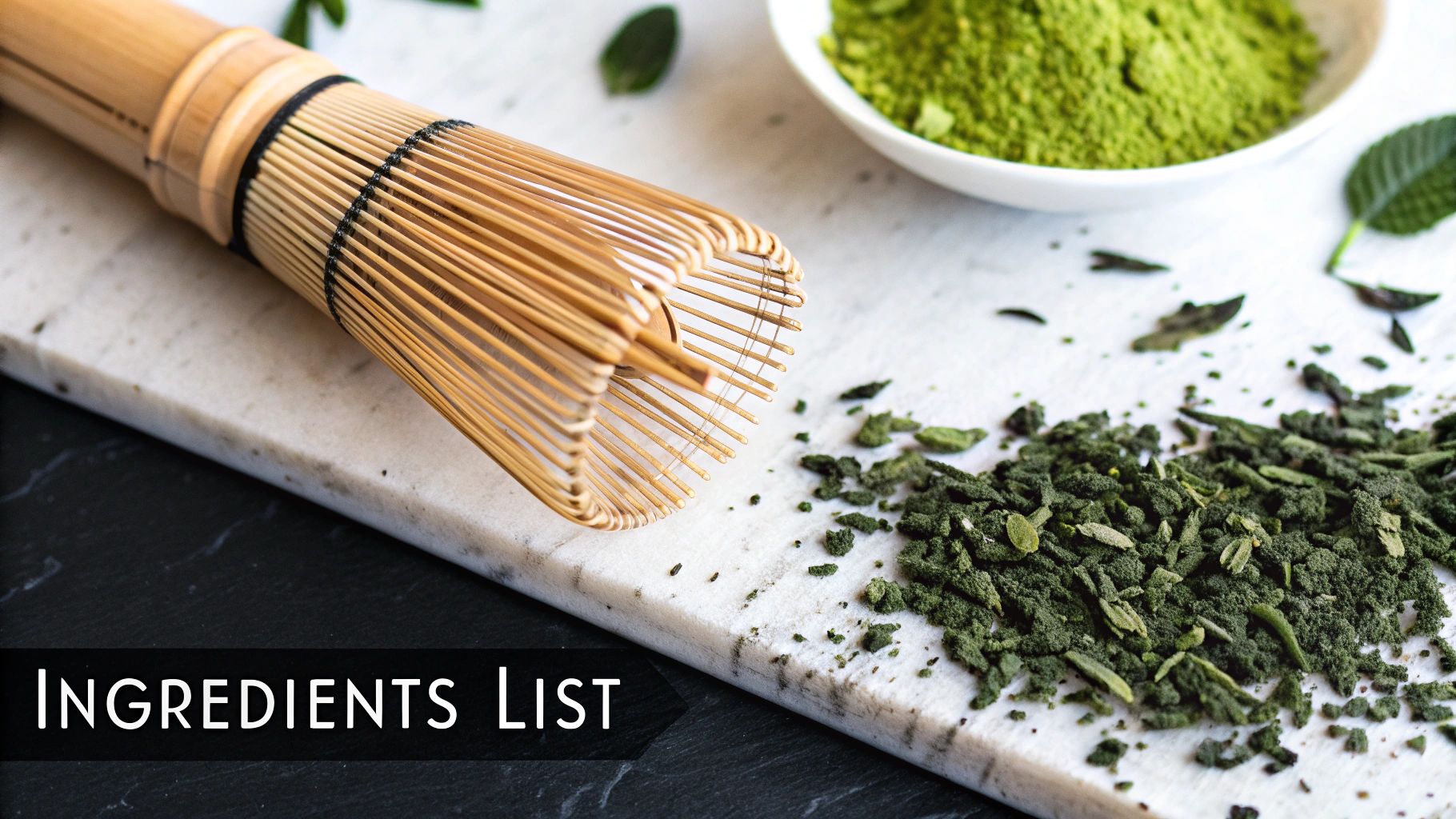
The secret to a truly exceptional matcha latte doesn't start with the technique—it begins with your ingredients and tools. Picking the right matcha powder is the single most important decision you'll make, as it sets the stage for the entire flavour profile and smoothness of your drink.
You really want to go for a high-quality ceremonial or latte-grade matcha. Trust me, it’s non-negotiable. Lower-grade, or culinary, matcha often has a dull, almost muddy colour and a bitter, astringent taste that even a lot of milk and sweetener can't fully cover up. Premium matcha, like the blends we've perfected at Amatsu, gives you that gorgeous vibrant green and the deep, smooth, umami flavour that makes a homemade latte feel like a proper café treat.
This is also where your daily cup can become a part of your wellness routine. By choosing a specific blend, your latte transforms from just a tasty drink into a functional ritual designed to support your goals.
Find Your Ideal Amatsu Matcha
When you find the right blend, your latte becomes so much more than a simple alternative to your morning coffee; it's a personalised wellness tool. And it's clear people are catching on. In fact, by 2025, the UK matcha latte powder market is projected to be worth around £55 million (approximately $70 million USD), which shows a real demand for top-quality ingredients to use at home.
To help you find your perfect match, this table breaks down our Amatsu blends.
| Amatsu Product | Best For | Key Ingredients & Benefits |
|---|---|---|
| Amatsu Pure | The purist seeking an authentic, classic matcha experience. | The quintessential ceremonial-grade matcha, offering a clean energy boost and that signature umami flavour. |
| Amatsu Radiance | Those wanting a beauty boost from their daily ritual. | Infused with marine collagen to support skin, hair, and nail health while you sip. |
| Amatsu Shrooms | Anyone needing enhanced focus and mental clarity without the jitters. | Combines matcha with adaptogenic mushrooms like Lion's Mane and Cordyceps for sustained concentration. |
| Amatsu Strength | Fitness enthusiasts looking to support muscle growth and recovery. | A powerful blend of matcha and high-quality creatine monohydrate to fuel your performance. |
Each of these turns your latte into something that does more than just wake you up. For instance, the adaptogens in Amatsu Shrooms offer a completely different kind of energy compared to your usual brew. If you're curious about how that works, you might find our guide comparing matcha vs. coffee caffeine really interesting.
The Right Tools for a Clump-Free Latte
Once you've got your matcha sorted, gathering a few key tools is the next step to ensuring a smooth, frothy result every time. You don’t need a complicated setup, just the right gear for the job.
The most common mistake is not creating a smooth matcha paste before adding the milk. Get this step right with a good whisk, and you've guaranteed yourself a silky-smooth texture in every sip.
A traditional bamboo whisk, or chasen, is the gold standard for a reason. Its fine tines are perfect for aerating the matcha and breaking up any stubborn clumps. But it’s not your only option.
An electric milk frother is a fantastic modern alternative that works quickly and efficiently to whip up a perfectly smooth matcha 'shot' before you even think about frothing your milk. So, whether you're a purist honouring tradition or just need something quick and easy, either tool will get you that coveted café-quality finish.
Mastering the Matcha Latte Method
This is where the magic really happens. We've got our ingredients, but now we get into the craft—the little details that take a matcha latte from just "good" to something truly special. Nailing these techniques is what will give you that coffee shop-quality experience right in your own kitchen.
Let's start with the most crucial step for a silky, lump-free drink: sifting your matcha. Honestly, this takes ten seconds and it’s your single best defence against a grainy texture. Just grab a small, fine-mesh sieve and gently push your Amatsu Matcha powder through it and into your bowl. This simple act breaks up any stubborn little clumps, ensuring the powder dissolves perfectly into the water.
Creating the Perfect Matcha Shot
With your matcha beautifully sifted, the next move is to create a concentrated 'shot'. Think of this as the vibrant, flavour-packed heart of your latte. This is where getting the water temperature just right is absolutely key.
You're aiming for hot water, but definitely not boiling. The sweet spot is around 80°C (175°F). If the water is too hot, it will scorch the delicate matcha, leaving you with a bitter, disappointing taste. No temperature-controlled kettle? No problem. Just boil the water, take it off the heat, and let it sit for a minute or two before you pour.
Now, add just a splash of this hot water to your sifted matcha. It's time to whisk.
The image below breaks down the three core stages of making your perfect matcha latte at home.
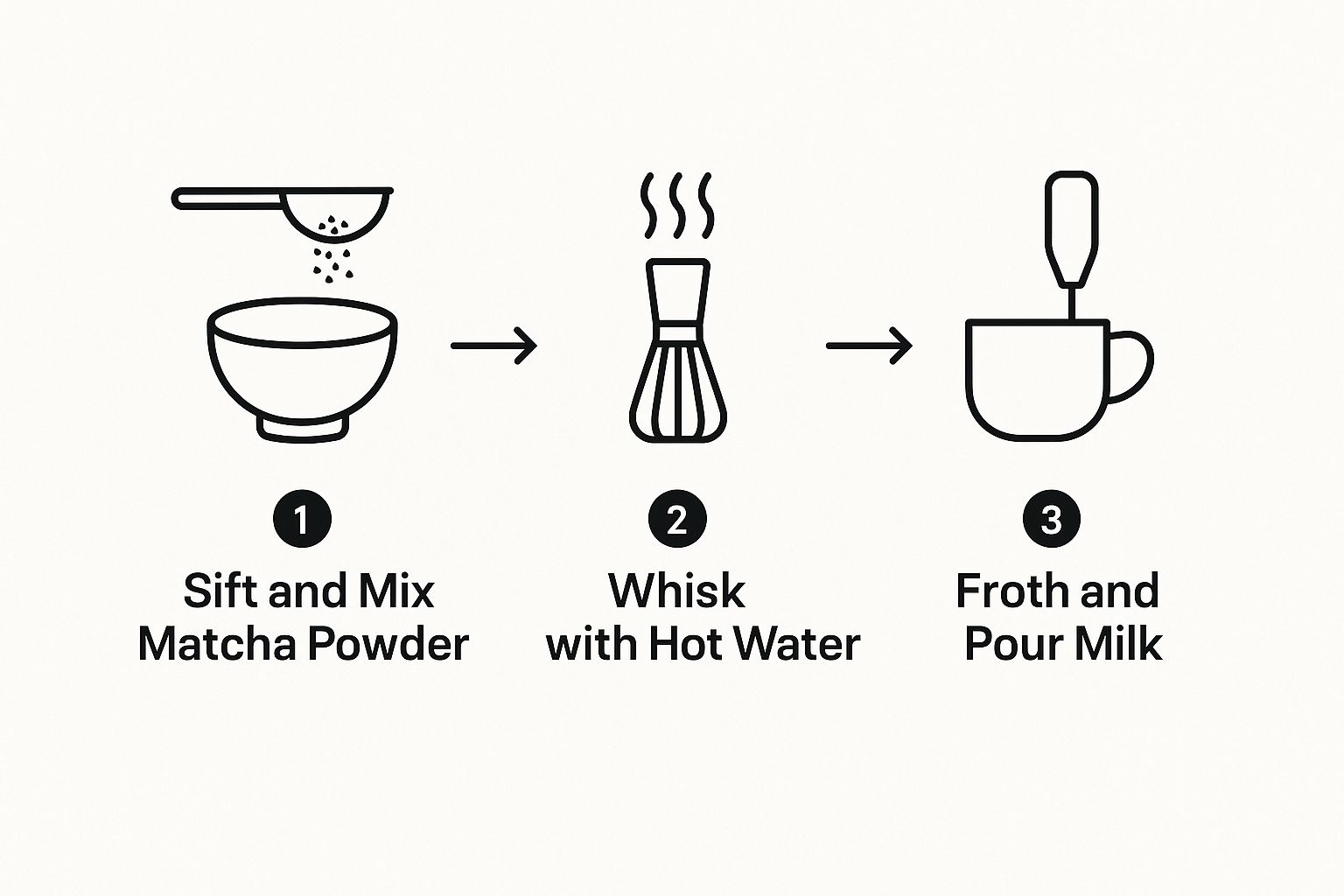
As you can see, it’s a simple flow: prepare, whisk, and finish. Sticking to this sequence is the secret to a flawless result, every single time.
The Art of Whisking
Whisking isn't just about mixing things together; it’s about aerating the matcha to create a smooth, frothy paste. This is where a traditional bamboo whisk, or chasen, really shines. Its many delicate prongs are designed specifically to suspend the matcha particles evenly and build that lovely foam.
Your movement should be quick and light, almost like you're writing a 'W' or 'M' in the bottom of the bowl. Forget stirring in circles—that won’t get you the froth you’re looking for. This rapid zig-zag motion forces air into the mixture, breaking up the powder and creating a velvety layer of foam on top. If you want to really master this, we have a whole guide on how to use a matcha green tea bamboo whisk.
The secret to a perfect froth isn't brute force; it's a rapid, light-handed 'W' motion. You’re not just dissolving the powder—you're awakening its flavour and creating that signature smooth texture.
Choosing and Preparing Your Milk
Once your vibrant matcha shot is ready and waiting, it’s time to think about the milk. What you choose here makes a huge difference to the final flavour and creaminess of your latte.
- Dairy Milk: For a classic, rich texture, you can't go wrong with whole milk. Semi-skimmed works well too if you prefer something a little lighter.
- Oat Milk: This is a fantastic choice for good reason. It froths up beautifully into a thick, stable foam and has a subtle sweetness that complements matcha's earthy notes perfectly.
- Soya Milk: Another brilliant frothing option. Soya milk creates a really dense foam and has a distinct taste that pairs surprisingly well with matcha.
- Almond & Coconut Milk: Almond milk is a lighter choice but can be a bit tricky to froth well. Coconut milk, on the other hand, adds a wonderful tropical richness for a more indulgent treat.
Gently heat your milk of choice on the hob or in the microwave until it's steamy but not boiling. To get that lovely foam, an electric frother is your best friend, though you can also get a decent result by pumping it in a French press.
The final flourish is pouring the frothed milk over your matcha shot. If you want that beautiful layered look, pour the milk slowly down the side of the glass, using a spoon to hold back the foam until the very end.
Personalising Your Signature Matcha Latte
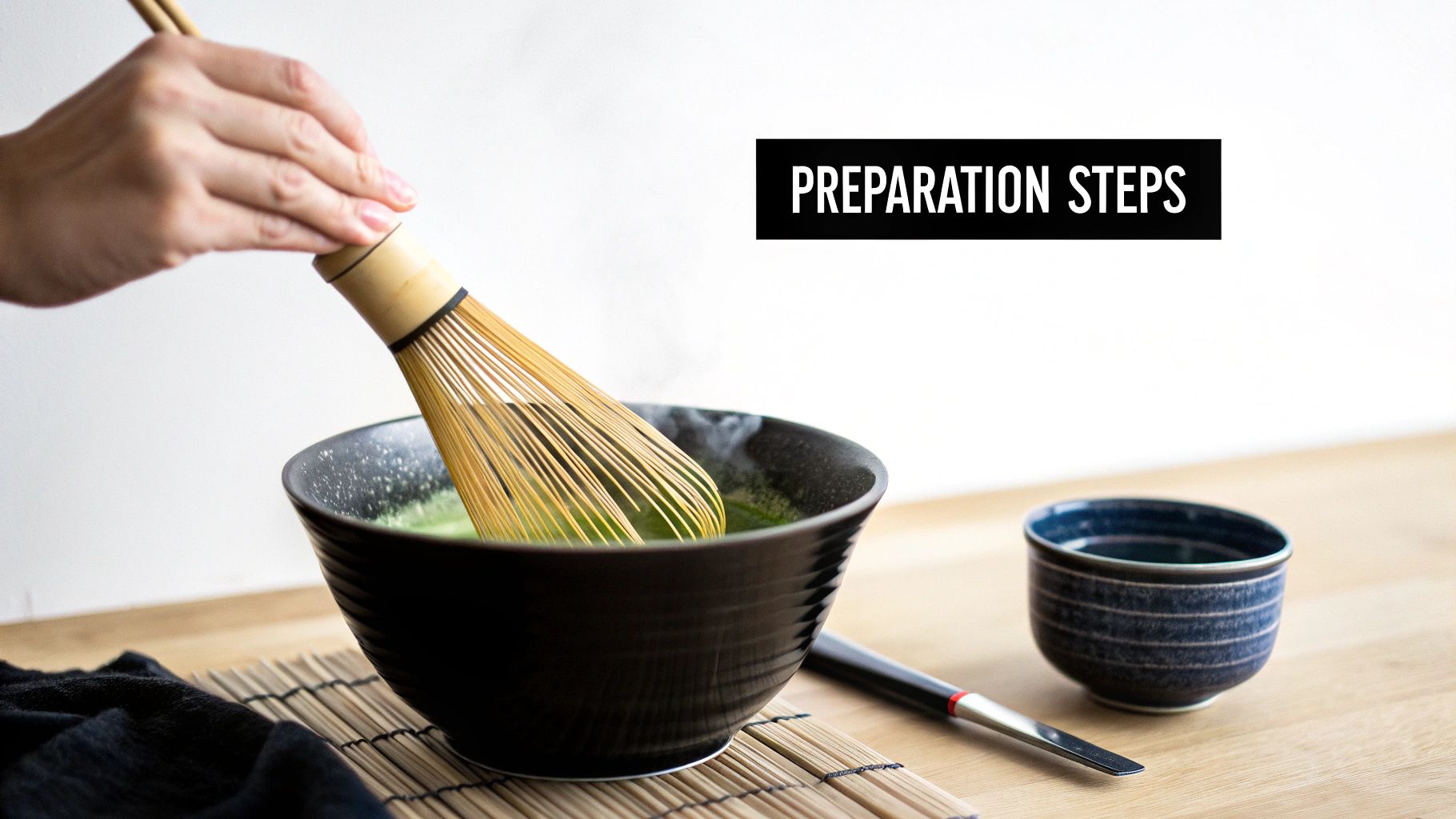
So, you've nailed the basics. Now for the fun part. This is where you go from following a recipe to creating your drink, becoming your own home barista. Your daily cup can change with your mood, the season, or whatever you feel you need that day.
The easiest place to start experimenting is with sweetness. Matcha's complex, slightly bitter notes are perfectly balanced by a little sweetness, but getting it right is a delicate dance.
Finding Your Perfect Sweetener
I find that natural liquid sweeteners are best because they dissolve seamlessly into warm milk without any graininess. Each one brings something a little different to the table.
- Maple Syrup: A fantastic go-to. It has a subtle, woody sweetness that complements the matcha without stealing the show.
- Honey: This adds a lovely floral note, especially if you use a light one like acacia or orange blossom honey.
- Agave Nectar: A more neutral choice if you just want pure sweetness without any competing flavours.
My advice? Start with just one teaspoon stirred into your frothed milk, then have a taste. You can always add more, but you can’t take it away. The goal is to enhance the matcha, not hide it.
The perfect matcha latte isn't about a rigid recipe; it's about listening to your own palate. Play around with sweeteners and spices to create a drink that feels uniquely yours and fits into your daily wellness ritual.
Adding Spices and Extracts
A tiny pinch of spice or a few drops of extract can completely change the character of your latte. A small dash of ground cinnamon, for instance, adds a warming, cosy feel that's perfect for a chilly morning. For something a bit more sophisticated, a few drops of vanilla extract can really bring out the creamy notes of the milk and soften matcha’s vegetal edge.
Think of it like seasoning a dish—a little goes a very long way. These additions work especially well with a classic blend like Amatsu Pure. Its high-quality flavour profile is a fantastic canvas for your creativity. If you want to dive deeper into what makes a premium powder so special, have a read of our guide on finding the best organic matcha from Japan.
Adapting for Amatsu Functional Blends
If you're using one of our functional blends like Amatsu Shrooms or Strength, you might want to tweak your approach to balance the flavours.
For the Shrooms blend, the rich sweetness of maple syrup beautifully complements the earthy, adaptogenic mushrooms. With the Strength blend, which contains creatine, a dash of cinnamon adds a warmth that works really well with its subtle taste. These simple tweaks can make your wellness routine feel like a real treat.
How to Make an Iced Matcha Latte
When the weather warms up, nothing beats a refreshing iced matcha latte. The process is nearly the same, just with a couple of small changes.
First, make your matcha shot just as you normally would, whisking the powder with 80°C water until it's perfectly smooth.
Next, add your chosen sweetener directly into the warm matcha shot and give it another quick whisk. This is a key step – it ensures the sweetener dissolves completely before it meets the cold milk. No gritty sugar at the bottom of your glass!
Then, simply fill a tall glass with ice and pour in your milk.
Finally, slowly pour the matcha shot over the top to get that gorgeous, layered look. Just give it a quick stir before you take that first delicious sip. It's the perfect way to enjoy your favourite Amatsu blend on a sunny day.
Troubleshooting Your Matcha Latte
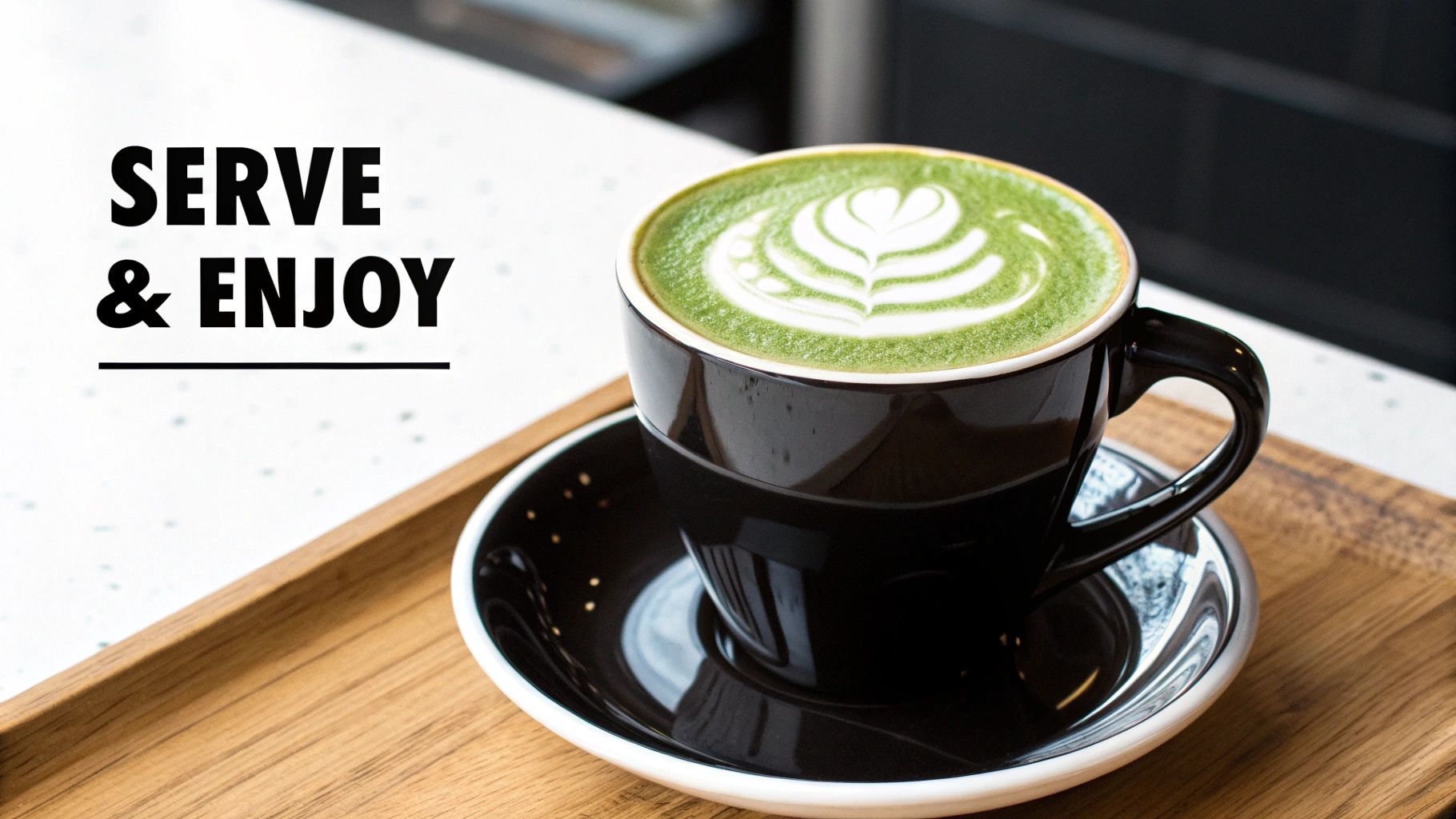
Even the most seasoned home barista hits a snag now and then. It’s all part of the process, so don’t be discouraged if your first few attempts aren't quite cafe-quality. Let's walk through the most common frustrations and get your latte back on track.
The growing love for matcha in the UK has certainly put the cost into perspective. A weekly treat could set you back around £301 a year, and that figure jumps to £925 for a thrice-weekly habit. It’s no wonder so many of us are perfecting our skills at home—which makes it all the more important not to waste any of that precious powder. Medino.com has some interesting stats on the cost of our matcha habits if you want to dig deeper.
Why Is My Matcha Clumpy?
This is, without a doubt, the number one issue people face. You go in for a sip, expecting that velvety texture, but instead, you find gritty little lumps of powder. Not pleasant.
- The Cause: Nine times out of ten, this happens because the matcha wasn't sifted or whisked correctly. Matcha is an incredibly fine powder, and it just loves to stick together the second it hits liquid.
- The Fix: Always, always sift your matcha through a fine-mesh sieve before you add any water. When you do add the hot water, use a quick 'W' or 'M' motion with your bamboo whisk. You're not just stirring; you're creating a suspension. For a full breakdown of the movement, take a look at our guide on how to whisk matcha correctly.
Why Does It Taste Bitter?
A bitter latte is a dead giveaway that something went wrong in the prep stage. High-quality matcha should be smooth and earthy, never harsh or unpleasantly sharp.
It's a common myth that all matcha is bitter. A true ceremonial-grade matcha has a rich, umami flavour with just a slight, pleasant astringency. If your latte is overwhelmingly bitter, it’s almost always down to your technique or the quality of your powder.
This problem usually points to one of two culprits:
- Your water is scorching hot. Pouring boiling water (100°C) over your matcha will burn the delicate tea leaves, which instantly releases a bitter taste. You should always aim for water around 80°C.
- You're using the wrong grade of matcha. Culinary-grade matcha is fantastic for baking, but it can be quite bitter when prepared as a drink. Starting with a premium powder, like Amatsu Pure, is the best way to guarantee a smooth, bitterness-free base.
Why Is My Latte Flat and Not Frothy?
If your latte lacks that luxurious, creamy foam on top, the problem is likely with your milk or your frothing technique.
- Milk Matters: Not all milks are created equal when it comes to foam. Full-fat dairy and oat milk are the undisputed champions for creating a thick, stable froth. Lighter plant-based milks, like many almond varieties, simply don't have the fat and protein content needed to hold their structure.
- Frothing Technique: The trick is to froth your milk until it has almost doubled in volume before you pour it over your prepared matcha. A simple handheld electric frother can work wonders here and is a great tool to have in your kitchen.
Your Matcha Latte Questions Answered
https://www.youtube.com/embed/M--Pj9jMXEM
As you get into making matcha lattes at home, you're bound to run into a few questions. That's completely normal—we've all been there! To help you get past the learning curve, I've gathered some of the most common queries I hear all the time.
Can I Make a Matcha Latte Without a Bamboo Whisk?
You absolutely can. Look, the traditional bamboo whisk, the chasen, is designed specifically to create that perfect, clump-free froth, and it does a beautiful job. But it's certainly not the only way to get there.
An electric milk frother is a fantastic, speedy alternative. It works brilliantly for whipping up a smooth matcha paste.
Don't have either? A small kitchen whisk will do the trick with a little extra elbow grease. My favourite hack in a pinch is to shake the sifted matcha and hot water together in a small, tightly sealed jar. Just shake it vigorously until it's completely smooth. The real goal, no matter the tool, is to create that velvety paste before you even think about adding the milk.
What Is the Best Plant-Based Milk for a Latte?
For me, oat milk is the clear winner in the plant-based world when it comes to matcha lattes. It just froths up so well, creating a lovely thick foam, and its natural, subtle sweetness is the perfect dance partner for matcha's complex, earthy notes.
Soya milk is another great choice, especially if you're chasing that dense, creamy foam. Almond milk brings a lighter, nuttier flavour to the table, though it doesn't tend to froth quite as well. For something truly decadent, full-fat coconut milk from a tin creates an unbelievably rich and creamy texture.
Ultimately, the "best" milk is the one you like most. Don't be afraid to experiment with a few different options to find what suits your personal taste.
How Should I Store Matcha Powder to Keep It Fresh?
This is a big one. Proper storage is everything if you want to protect your matcha's vibrant green colour and delicate flavour. Once you've opened it, keep your matcha powder in an airtight, opaque container. Honestly, the tin your Amatsu Matcha came in is perfect for this. Just pop it in a cool, dark place, like a cupboard that's well away from the heat of your hob or oven.
Air, light, and heat are the enemies of fresh matcha. It's that simple.
For any unopened tins you have, storing them in the fridge can help extend their shelf life. The key here is to let the tin come all the way to room temperature before you open it. This stops any condensation from forming inside, which is crucial for preventing clumps and preserving the quality of the powder.
You might also notice that high-quality matcha gives you a much smoother, more sustained lift throughout the day compared to coffee. If you're curious about the science behind it, you can read more about how matcha works for energy over on our blog.
Your journey to the perfect homemade matcha latte is a rewarding ritual. To ensure every cup is smooth, vibrant, and packed with wellness benefits, start with the finest ingredients. Explore the full range at Amatsu Matcha and find the perfect blend to elevate your daily routine. Visit https://amatsumatcha.com to begin.
Read more
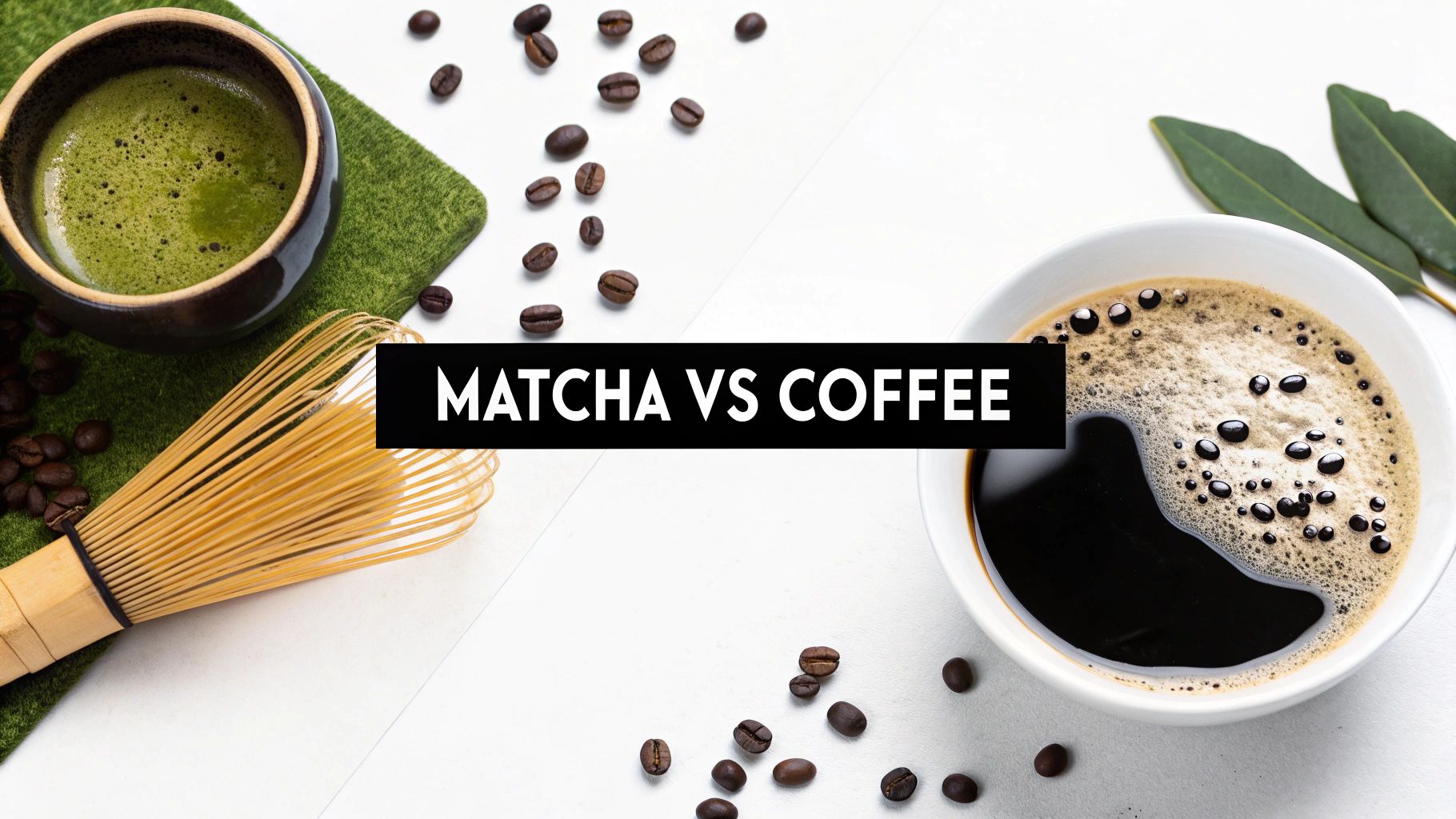
Uncover the truth about matcha vs coffee caffeine. We compare the energy release, health benefits, and side effects to help you choose your ideal daily boost.
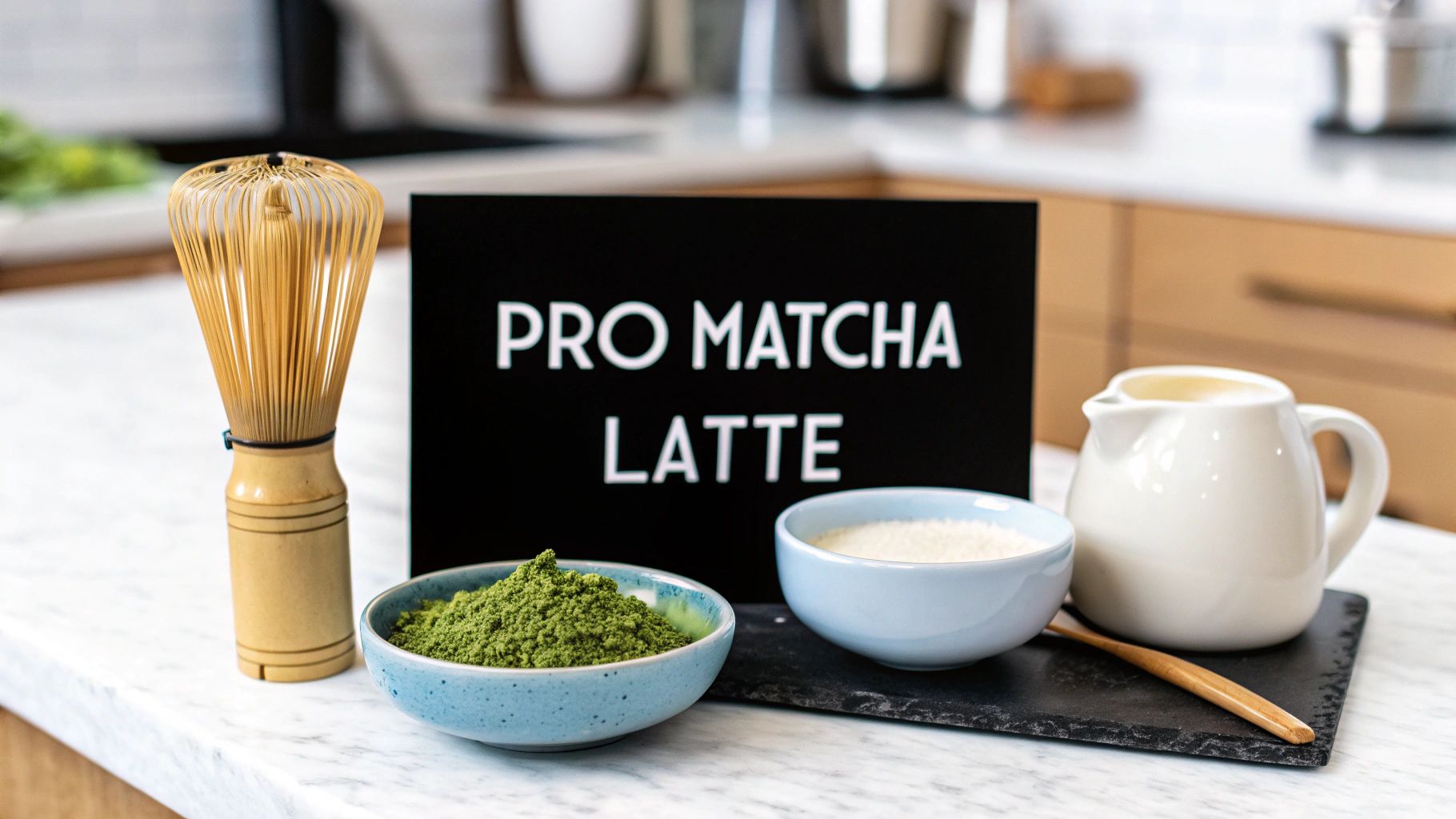
Learn how to make matcha latte with this easy guide. Get pro tips, choose the right matcha, and craft a café-quality drink in your own kitchen.
